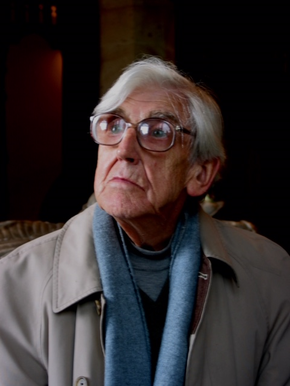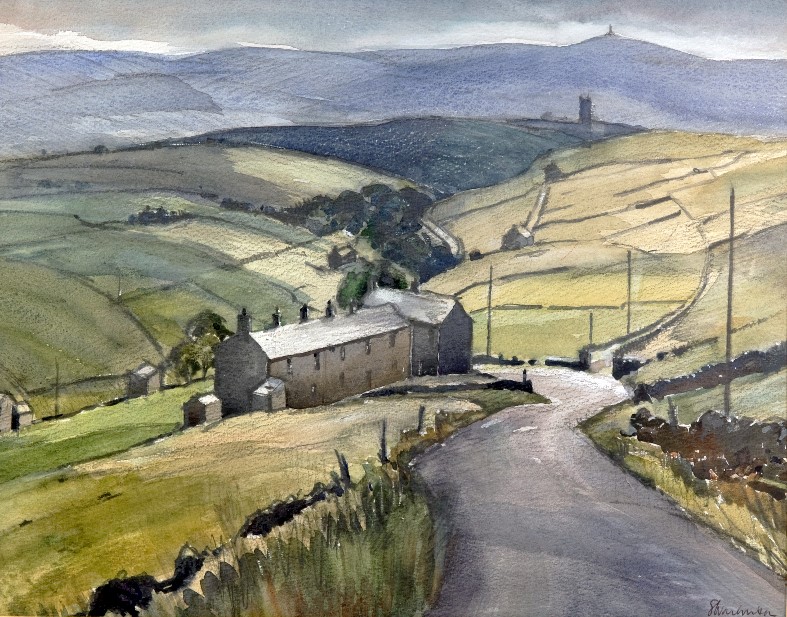The Long Causeway, Looking back to Heptonstall, Yorkshire
|
Research by Anne Matthews
|
|
Acc No 229
Artist Warburton, Stanley Artist dates 1919-2012 Medium watercolour Size unknown Date painted unknown Donor The artist in thanks for his exhibition An Art Refined, 2012 Date donated 13 April 2012 Also in the Collection by the same artist Hebden Bridge and The Old Bridge Over Gayle Beck, Hawes |
|
ARTIST
Stanley Warburton was an accomplished and well respected artist who, although specialising in landscapes, both watercolour and oils, also produced portraits and still life. He will be remembered, in particular, for the personal vision and style he brought to the landscapes through his intimate knowledge of the towns and villages of his much loved South Pennines. Stanley was born on 19 March 1919 in Heywood, Lancashire, the younger son of Harry, a textile engineering draughtsman and Martha (nee Wolstenholme), who had been a cotton weaver before her marriage. Following in his father’s footsteps Stanley also became an engineer/draughtsman, later becoming a teacher of engineering subjects in a number of Technical Colleges, but finding time to visit art galleries and museums around the world. He was artistically inspired from an early age by the paintings of his grandfather, Daniel Warburton (1859-1919), which adorned his grandmother’s home. The Bury artist, who died the year Stanley was born, left a small book, ‘Turner the Artist’ by Rev SA Swaine. An omen of things to come! Although mainly self-taught, Stanley amassed an academic knowledge of the different techniques of many artists. In addition to his fascination with JMW Turner (1775-1851) and JS Cotman (1742-1782), he was influenced in the early stages of his career by Cezanne, Vlaminck, Stanley Spencer, John and Paul Nash and Wilson Steer. He studied at the School of Art in Bury and exhibited at the Manchester Academy of Fine Arts, where he met and befriended LS Lowry, whom he considered his mentor. He recalled Lowry visiting his first one-man show in 1951 and his advice ‘not to read too much nor to see too many paintings by other artists but to retain his own vision’. Stanley also acknowledged his good fortune in having John Bold, a fine Lancashire artist, as his teacher. In turn he has become an inspiration to others. Maurice Greenwood RCA (1930 - ) in his online profile writes of the encouragement and advice he received from Stanley from an early age and is ‘still much inspired by his work’. During his youth Stanley had been impressed by Turner’s Liber Studiorum - a set of seventy-one studies engraved from some of his etchings, which were hung around the cupola in Bury Art Gallery. This interest was re-stimulated in 1975 (Turner’s bicentenary). Stanley was pivotal in founding the Northern Branch of the Turner Society, serving as Chairman from 1977, and subsequently as Vice President, from 1984 to 1988, of the national Turner Society in London and through this position forged artistic links with Prince Charles. He helped to organise three Turner Exhibitions, ‘Turner in Yorkshire’ at the York City Art Gallery in 1980, ‘Turner and Dr Whitaker’ at Townley Hall, Burnley in 1982 and finally, ‘Turner in Wales’ at Llandudno Mostyn Gallery. Stanley’s own work has been the subject of several exhibitions in the north, the final one being An Art Refined at the Fylde Gallery in Lytham (2012), when nearly 70 works were displayed. Stanley also self-published three books. The beautifully illustrated ‘Discovering Turner’s Lakeland’ (2008) and ‘John Sell Cotman – The Gentle Genius of Norwich’ (2010), which complements the pocket biography of ‘Artist Extraordinary John Sell Cotman’ published in 2003. In addition to his painting and writing Stanley was also very much in demand as a lecturer at various prestigious institutions, including the Royal Academy and Tate Liverpool, as well as numerous art societies throughout the North West. He retired to Lytham St Annes in the early 1990s, where he quickly associated himself with local societies, becoming the President of the Lytham St Annes Art Society in 1994/95. He continued to advise young artists and generously passed on his skills to aspiring artists in local schools until he died in August 2012. He currently has two oil paintings in the Leamington Spa Art Gallery, Young Teenager and Self-Portrait as a Young Man (1949), as well as exhibits in several North West public art galleries including Bury Art Gallery and Museum who have two oil paintings, Snow at Marland (1951) and Pennine Landscape (1996) and a watercolour, Selside, near Horton (1965). Rochdale Art Gallery has a watercolour, Butterworth Hall, Milnrow and there is a further watercolour, Hebden Bridge, in the Lytham St Annes Art Collection. Other paintings include: (oils) Hebden Bridge, The Road to Keighley Springtime in Saddleworth Lane to the Farm Morning Light on the Rochdale Canal at Castleton (watercolours) Elterwater, English Lakes Grassington, Yorkshire Heptonstall Church Houses in Todmorden Luddenden, Yorkshire PAINTING Heptonstall is a small Yorkshire village in the Upper Calder Valley, which includes some of the most beautiful and remote scenery in the South Pennines. Above the valley and running parallel to the principal Burnley-Todmorden road is a dramatic high level traverse, thought to be a medieval packhorse route over the moors, known as The Long Causeway. It follows the length from Burnley, via Mereclough, where a large hoard of Roman coins was found in 1654, to Hebden Bridge. Despite the large farm building on the left of the painting, a noticeable feature here is the lack of both human and animal activity. The emphasis is on the landscape itself, grey skies in the distance, pale sunlight highlighting the old farm stone buildings and the moorland, brooding and beautiful in equal measure. Using ‘the low-toned approach’, the artist has chosen to work in pure watercolours, appropriately subdued, to great advantage. Stanley’s skills with regard to perspective and distance have been well documented. When discussing composition he is quoted as saying ‘see how important (that) is to balance the picture and lead your eye into the intersecting axis’ and that thought process is clearly in evidence here. As with many of his paintings, the road is central to the subject, leading the viewer on a journey over the moorland and then, without time to catch one’s breath, onward again to even higher ground and the impending rain. |
 Stanley Warburton, photograph courtesy of Brian Thomas, who also framed his paintings Stanley Warburton, photograph courtesy of Brian Thomas, who also framed his paintings
r
REFERENCES www.burnley.gov.uk www.buryartsociety.co.uk www.bury.lhs.org.uk [email protected] www.rcaconwy.org (Maurice Greenwood) www.forbears.co.uk www.rocles.blogspot.co.uk www.british-history.ac.uk www.org.wiki.cliviger [email protected] Census 1861/1871/1881/1891/1901/1911 Rochdale Register Office DFAS ‘In the Picture‘ Newsletter, article by Veronica McDonnell, 6 October 2012 DFAS 'In the Picture' Newsletter, article by Hilary Alcock, 5 March 2012 Pennine Magazine, article by Susan Bourne, April 1984 Alan Bealey, LSAAS Lytham St Annes Art Society Special thanks to Arthur Barnes of St Annes for sharing his special memories of Stanley |

